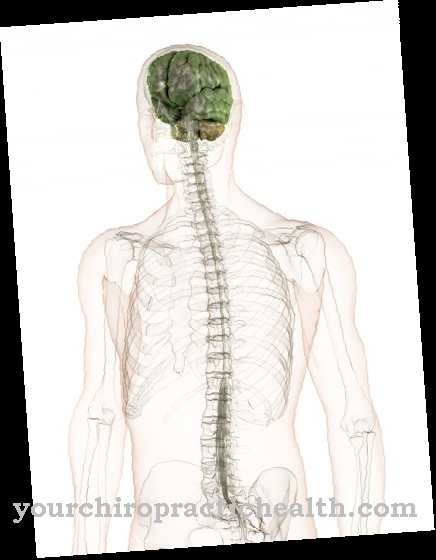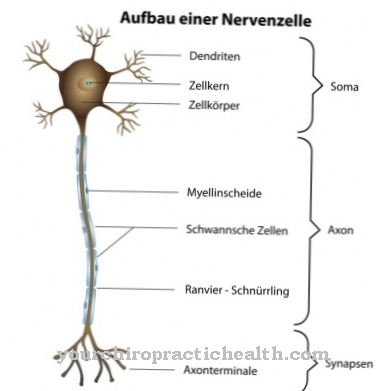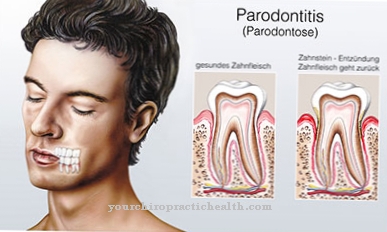Not only fires can Smoke inhalation cause. If medical help is on hand early, smoke inhalation is usually favorable.
What is smoke inhalation?

© Sean Thomforde - stock.adobe.com
A Smoke inhalation mostly caused by inhaled poisons that can be found in smoke. For the majority of people who develop smoke inhalation, the poisoning usually happens while sleeping.
One reason for this is that various breath poisons in smoke are odorless for humans and therefore do not cause the person concerned to wake up. Most of the fatalities after fires do not die from burns, but from severe smoke inhalation.
Typical symptoms of smoke inhalation include, for example, severe shortness of breath and dizziness. The severe shortness of breath in those affected is often accompanied by a feeling of suffocating. Headaches are also common symptoms of smoke inhalation. Occasionally, those affected also have seizures and / or palpitations.
causes
A Smoke inhalation is mostly caused by building fires. Since it is not the smoke itself that leads to smoke poisoning, but rather the breath poisons contained in the smoke, such as carbon monoxide (which is why there is an alternative term for smoke poisoning in medicine Smoke poisoning), various other factors can also be responsible for the poisoning.
For example, some smoke inhalation is the result of inhaling large amounts of exhaust gases. Defective boilers or stoves can also be the cause of smoke poisoning.
Serious consequences of smoke poisoning, such as loss of consciousness, which can lead to the death of a person affected, are caused by the respiratory toxin cyanide in a fire. This breath poison is created, among other things, by the various burning objects.
Inhaled cyanide blocks the functioning of the body's cells, so that the cells lack oxygen. As a result, internal suffocation often occurs.
Symptoms, ailments & signs
The symptoms of smoke inhalation can be many. The timing of complaints can also vary. This depends on the type and intensity of the gas. Typical signs of smoke inhalation are severe coughing and shortness of breath. In addition, the inhaled substances often lead to severe headaches, dizziness and nausea.
The interference from the gases can also cause sweats and muscle cramps. The toxic substances in the smoke can also make you feel drowsy and confused. A reddish / bluish discoloration of the skin can also appear as a symptom of smoke gas intoxication. Evidence of smoke inhalation can also be burns in the neck and face area.
Clues for smoke gas poisoning can also be soot particles in the mouth and hair that smells burnt. Classic signs are also difficulty swallowing, strong inner restlessness and recognizable feelings of fear. Speaking can be strenuous and interrupted by coughing up phlegm.
Depending on the pollutant, it can lead to weak limbs and burning pain in the respiratory tract. Burns to the airway mucous membranes are also possible due to the effects of heat. As a result of smoke inhalation, palpitations can set in. Smoke inhalation noticed late or untreated can lead to unconsciousness. In the worst case, breathing will stop.
Diagnosis & course
As patients with an acute need for treatment Smoke inhalation are often unconscious, an emergency diagnosis must usually be based on the observable condition of a patient. It is not possible for mobile emergency doctors to detect a cyanide concentration in the blood, so that treatment for smoke poisoning that is required quickly is often based on the suspected diagnosis.
The course of smoke poisoning varies from person to person and depends, among other things, on the degree of poisoning and the symptoms that occur. Above all, rapid medical intervention has a positive effect on the course of smoke inhalation:
If such poisoning can be treated at an early stage, it is usually associated with a good prognosis. However, if medical help is not on-site early, smoke inhalation can be fatal.
Complications
Depending on the pollutant inhaled, smoke inhalation can cause various complications. In general, acute complications such as seizures, palpitations, and loss of consciousness occur. In the further course pulmonary edema forms, which, if left untreated, can lead to pneumonia and in extreme cases to death of the patient. Long-term effects can also occur as a result of severe poisoning.
If the mucous membranes are damaged, this promotes infections and diseases of the immune system. Scarring of the lung tissue affects the blood circulation and can cause shortness of breath and damage to the heart, among other things. In the case of severe damage, breathing difficulties occur even at rest. The shortness of breath often leads to panic attacks and, in the long term, to psychological complaints. When treating smoke poisoning, for example, prescribed medication can cause symptoms.
Heart-lung massage can cause rib or sternum fractures, and liver and spleen injuries. In addition, air or blood can enter the area between the pleura and the pleura, causing vomiting and aspiration. If blood gets into the pericardium, it can cause a heart attack. With ventilation there is a low risk of injuries and infections of the nasopharynx.
When should you go to the doctor?
If dizziness, nausea, or unsteady gait occur, there is cause for concern. In the case of smoke poisoning, the ambient air is unclean, which leads to a gradual decrease in internal forces. The lack of oxygen causes the affected person to sweat, develop internal heat or feel weak. A doctor is needed when consciousness is clouded, concentration and alertness disorders occur, and confusion sets in. Irregularities in the memory function, disorientation or states of fear are alarm signals of the organism. A doctor must be consulted because immediate action is required. Often there is a fear of suffocation, which leads to panic behavior. Vomiting, coughing, and shortness of breath are other signs of smoke inhalation.
In the event of loss of consciousness, an emergency service must be alerted. People present are also obliged to initiate first aid measures to ensure the survival of the person affected. Breathing activity must be supported in order to avoid further complications. Restrictions in movement sequences, a loss of muscle strength and a scratchy throat also indicate inconsistencies. If you have a headache, general dysfunction or sudden tiredness, the person concerned needs help. A doctor's visit is necessary to clarify the cause.
Treatment & Therapy
One is in need of treatment particularly quickly Smoke inhalation, if the respiratory poison cyanide is involved, because cyanide affects the body cells comparatively quickly. However, since cyanide involvement cannot be proven in the emergency situation, general emergency medical measures are usually taken on site: In the event of smoke poisoning, for example, the patient's airways are initially kept free. The stabilization of the heart and circulation are also important immediate measures.
At the same time, a patient is also supplied with sufficient oxygen and fluid. If seizures occur as part of smoke inhalation, these are also treated with emergency medicine. For example, if there is a strong suspicion, based on various characteristics of the scene of the accident, that the person concerned is smoke poisoning with the involvement of cyanide, an antidote can be administered by doctors.
Such an antidote means that cyanide that has already penetrated the body's cells is neutralized. Thus the suffocation of a person affected can be prevented. The administration of antidotes for smoke inhalation is usually done with the help of an infusion. If smoke poisoning has already led to circulatory and / or respiratory arrest, resuscitation measures via a heart-lung massage or a donation of breath are necessary. This is often followed by artificial ventilation.
You can find your medication here
➔ Medication for shortness of breath and lung problemsprevention
As most Smoke inhalation occur during the night, an effective method of prevention is to adequately equip your home with fire alarms. Corresponding fire detectors trigger an early alarm in the event of a fire. This means that medical helpers can be on site quickly, which can often prevent serious consequences of smoke inhalation.
Aftercare
Follow-up care for smoke poisoning can be discussed with your general practitioner or pulmonologist. The aim is to optimize regeneration and to rid the organism of harmful substances in the long term. It is important to fill the lungs, bronchi and nose with fresh air. Walks in natural surroundings are therefore particularly suitable.
On the other hand, those affected should avoid staying in traffic-intensive areas for some time. If you can arrange it financially and in terms of time, you can treat your body at the sea or in the high mountains to an optimal air change for aftercare after smoke inhalation. Conscious breathing and gently dosed movement can make the aftercare process even more optimal in this context.
Breathing exercises can also be included in the follow-up care after a severe form of smoke inhalation. These can be learned from the physiotherapist and integrated into home practice. Yoga can also help to regenerate breath. Pranayama, the breathing exercises that occur in almost every yoga class, often positively regulate the flow of breath.
Good air in living rooms, bedrooms and in the office must also be ensured after smoke inhalation. Regeneration after smoke inhalation is also promoted by drinking a large amount of water. It serves to transport remaining pollutant particles in the respiratory system or in the rest of the organism more easily on the body.
You can do that yourself
If there is any suspicion that you or someone else has suffered smoke inhalation, first aid must be given. After alerting the ambulance, the first aider has to open windows and doors to ensure the oxygen supply. The person concerned must be brought out of danger and be kept quiet.
In the case of a slight smoke poisoning, it is important to keep calm or to have a calming effect on the poisoned person. Depending on the cause of the smoke poisoning, the first aiders should also find out whether other people are in danger and whether there may be further health risks from escaping gases. If the sick person has difficulty breathing, they should be positioned with the upper body elevated. Jackets and tight tops need to be loosened. In the event of unconsciousness, life-saving measures such as a breath donation or cardiopulmonary resuscitation may have to be initiated.
After smoke inhalation, those affected usually feel sick and weak. It is important to be careful and to rest. In addition, no strenuous exercise should be done for a day or two. The doctor responsible will usually suggest a further check-up, which should be used to minimize the health risks. After severe smoke inhalation, the person concerned has to spend a few days in the hospital. Self-help focuses on dealing with any trauma or shock and following the doctor's instructions.



.jpg)























